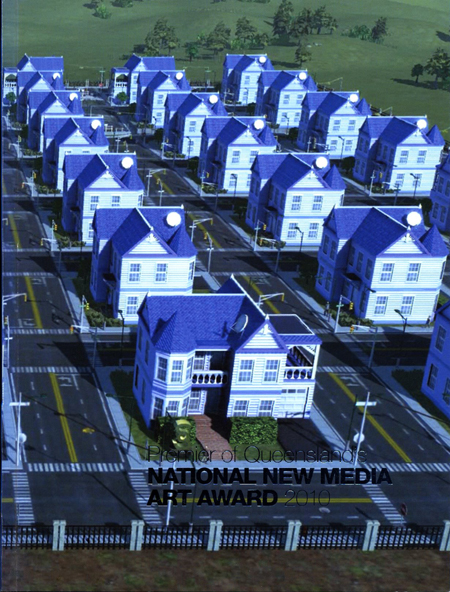Catalogue Essay
10 Flaming Youths
from the National New Media Art Award catalogue, Gallery of Modern Art, Brisbane © 2010
by Russell Storer
Philip Brophy's new digital animation 10 Flaming Youths (2010) is just as described: ten portraits of young people surrounded by flames. An instant personal association is a Neil Young lyric from 1979: "it's better to burn out than to fade away" .The line suggests a desire to never grow old, but was actually written in response to the rise of punk and new wave music which aimed to render Young's generation of musicians obsolete. His credibility with the kids was revived later, however, through his association with 1990s grunge bands — most infamously when Young's lyrics were quoted in 27-year-old Nirvana singer — songwriter Kurt Cobain's suicide note in 1994.
These references betray my age; I'm from generation X, which, give or take a few years, are those born between the late 1960s and the late 1970s. The incandescent youths in Brophy's work must be members of generation Y (aka the Millennials), born between the late 1970s and late 1990s, or perhaps even younger. Post-1990s children have been labelled generation Z — or Generation I, standing either for the internet or for the narcissistic, celebrity-focused, social networking-obsessed nature of our time. Either way, my pop-cultural sources may mean little to them — just fragments of prehistory that have again faded into the black.
The branding of young generations — from the 'flaming youth' of the 1920s to the postwar baby boomers to the recent alphabetised versions — reflects the growing social and financial independence of teenagers in the modern world. They are ideal market targets, trend leaders dedicated to how they look and what they own. Their categorisation into discrete demographics has been an immensely useful device for social analysts and corporations alike, and, indeed, Brophy sourced the faces in his work from those of models on youth marketing websites. Rendering their blandly beautiful features into drawings, he then translated them into vector images for animation. With its extreme two-dimensionality and collapsing of the genres of art, design and popular culture, Brophy's aesthetic recalls what artist Takashi Murakami has described as 'superflat' in Japanese art and consumer society.' According to Brophy:
"... hovering somewhere between airbrushed sterility, wall-stencilled sharpness and manga-styled appearance, the look... employs Pop effects to iconise the individual portraits... No action or even desire is suggested by their faces; indeed, their 'emptiness' is exactly what youth marketers/branders would like most youth to be. In this sense, their sullen lack of presence is perfectly achieved via the graphic flatness of their chiselled features."
10 Flaming Youths follows Brophy's public art project 10 Transforming Youths 2009, which also features portraits of young people undergoing metamorphosis. In 10 Transforming Youths, a row of faces rolls by as if on an assembly line, with each in turn materialising in the foreground and ageing before our eyes — some imperceptibly, some dramatically — and then returning to their original state. In 10 Flaming Youths, the figures move in and out of the background towards the viewer, generating a flickering aura of fire as they near the front of the screen, before fading away again. Fire is, of course, a transforming and purifying agent, offering renewal as well as destruction; yet these adolescents, unlike the phoenix, seem to emerge unchanged by their experience. They simply move on.
Brophy's work has always been concerned with transitional states, making links between the tangible and the intangible, the intellectual and the visceral. His extensive writing on film and sound, for example, offers a significant counter to traditional modes of reading and viewing cinema, in which images and narrative flow dominate. Brophy has consistently argued for the importance of the elements we don't see but feel intensely, the dynamic relationships between things that generate our emotional and sensory responses rather than simply what we see before us. Invisible yet powerful human drives, sensibilities and sensations are given the same presence and emphasis in his work as images and physical forms. His 10 Flaming Youths appear to be pure, commodified icons, yet, as with advertising or pop music, we relate to them personally. Perhaps we find familiarity in their features, or are moved by the washes of ambient sound that herald them. Perhaps they exactly describe our mood right now. Or maybe it's that they remind me, at the age of 40, that there's nothing you can do about the ever-so-fleeting 'flame of youth' — it's just something you are born with and take for granted, until it's gone forever.





